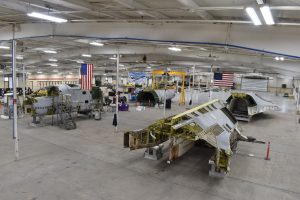In the air, the US Air Force B-1 Lancer bomber can reach top speeds of more than 932 miles per hour (1,500 kilometers per hour). Transporting it on the ground is another matter entirely. But that’s exactly what happened as part of a mission-critical project to drive readiness improvements across the B-1 fleet. The fuselage of a retired bomber was loaded on the back of a truck and driven over 994 miles (1,600 kilometers) across the US from Arizona to Kansas. Even without its wings and tail, the huge airframe took up three lanes of traffic and, at 146 feet (44.5 meters) long, stretched out roughly the size of half a football field.
Even without its wings and tail, the huge airframe took up three lanes of traffic and, at 146 feet (44.5 meters) long, stretched out roughly the size of half a football field.
Now in a hangar at Wichita State University (WSU) National Institute for Aviation Research (NIAR), the B-1 airframe is being taken apart piece by piece, all the way down to its nuts and bolts. Each part is then 3D scanned to create a full-scale, operational virtual twin. The program will provide the US Air Force with unprecedented information on the B-1 and promises to revolutionize the way the government procures replacement parts and keeps aircraft mission ready.
It’s a matter of national security. An airframe designed before the digital age, there is no living record of the complete design. A 3D virtual twin will change that and NIAR is the ideal candidate to make it happen.
“We have a unique set up here and we have the ability to handle every stage of the virtual twin program,” said Melinda Laubach-Hock, director of sustainment at NIAR.
to establish the product structure ahead of time, track all the parts, create CAD model drawings of every part and virtually reassemble the full aircraft. In future, it’s hoped that this project will serve as a pilot for the development and validation of a wider virtual twin strategy to support similar legacy aircraft and modern fleets, too.
“This program is preparing the government to handle new data and embrace a new way of doing things digitally,” Laubach-Hock said.
Read the full story here to discover more about this exciting project and how virtual twin experiences open the door to achieving the best possible aircraft sustainment and fleet readiness.

